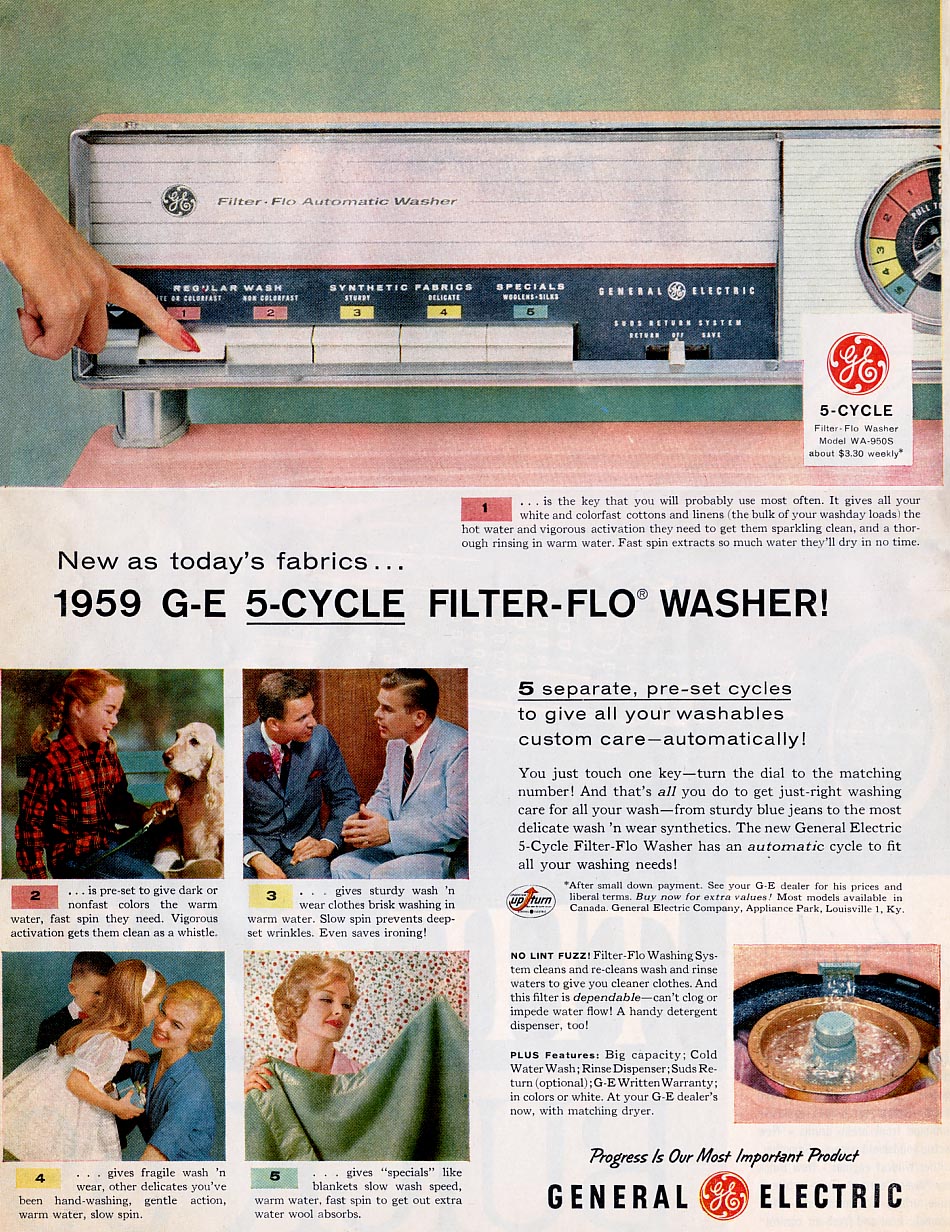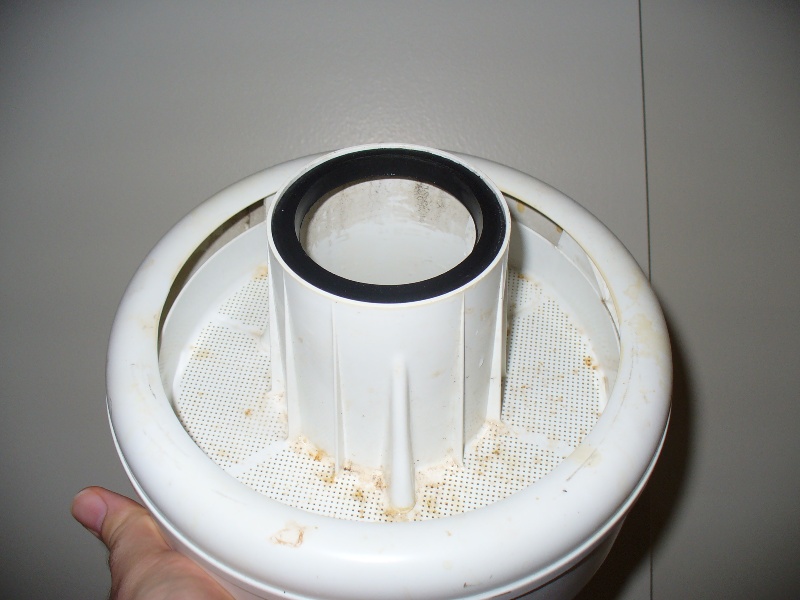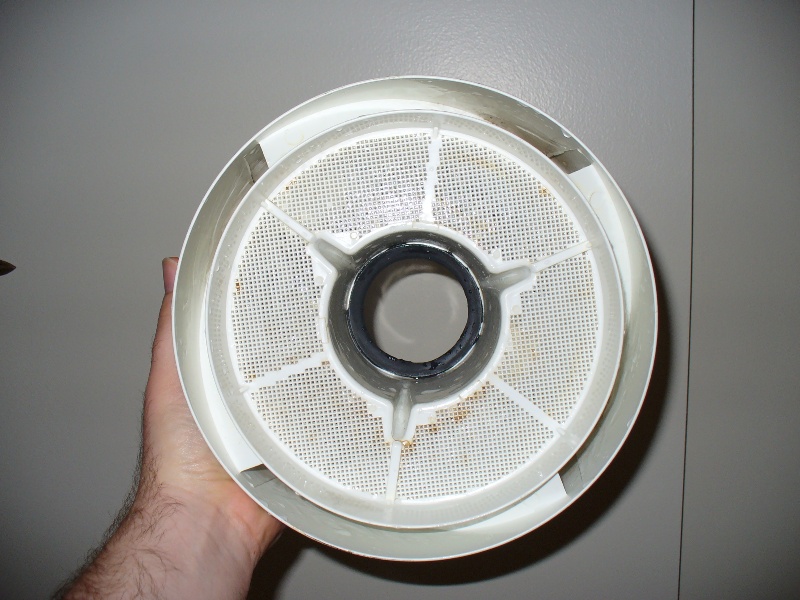|
Thread Number: 14769
Suds-saving...what about!? |
[Down to Last] |

|
Post# 250598 , Reply# 1 11/27/2007 at 09:59 (5,988 days old) by bajaespuma  (Connecticut) (Connecticut) |
||
Diomede,
Generally, the suds saver feature used a separate smaller pump that would divert the WASH water(and only the wash water, I believe)to a different drain hose that needed to be placed in a dedicated wash tub(with a plugged drain). With the GE models, if the user selected the "SAVE" option, wash water would be drained into that tub and would remain there until the user selected the "RETURN" option on the washing machine's control panel. I have never used one and there are many other members who are much more experienced with these than me. You can also go to the "Vintage Fun Stuff" section of this site and see a cutaway of a 1958 GE solid tub model that has the suds-saver feature and you can see some of the mechanics of it. By the way, I LOVE your country and have only been there 3 times (never enough time!). Your land, your people, your food (Oh Lord) are all beautiful. 
| ||
Post# 250607 , Reply# 2 11/27/2007 at 11:46 (5,988 days old) by dadoes  (TX, U.S. of A.) (TX, U.S. of A.) |
||
|
Whirlpool belt-drive models used a single pump, with a divertor valve and two drain hoses. The wash water *always* drained to one of the two hoses (which was placed in a utility tub or storage tank) and the rinse water exited through the other hose. There was no separate switch to preset whether or not to save the wash water. If one did not want to save the wash water, the utility tub was left unstoppered so that it drained away immediately. To return the saved wash water, the timer was set at a "Suds" position, which activated the valve so that the pump sucked the water back in through the drain hose. The machine agitated while the water returned. 1.5 to 2 inches of water where soil settled was left in the storage tub to avoid sucking it back into the machine. The timer automatically advanced into the wash phase of the Normal cycle, and added fresh water to top-off the water level if needed. If the user wanted to use a cycle other than Normal, the timer was manually reset after the water return was complete.
| ||
Post# 250624 , Reply# 5 11/27/2007 at 14:23 (5,988 days old) by dadoes  (TX, U.S. of A.) (TX, U.S. of A.) |
||
|
My GWL08 Use/Care guide outlines several "manual" choices for water or suds saving: 1. Re-use the wash water for another load by selecting the Soak option for the first load (this allows time to get to the machine before it drains). Remove the clothes from the wash water and restart the cycle, add more detergent if needed and manually select a water level. Let the second load run to completion, then replace the first load and start the cycle at the rinse phase to finish it. 2. Re-use the rinse water for washing a second load (in cold water). Select Spin Hold. Remove the first load, load the second batch and restart the cycle. The second load runs to completion. Re-load the first load and run it through spin. Both of these methods are messy, as they require pulling dripping-wet clothes out of the machine. 3. Manual Suds Save with Siphon-Back. Requires a storage tub of at least 27 gallons capacity. Select Soak. At the end of the wash phase, place the drain hose into the storage tub. Cancel Soak by pressing Advance to begin draining. When drain is complete, move the drain hose back to the standpipe. Allow the first load to finish. Siphon the saved water back in by setting the machine to spin and let the pump run for a few seconds. Press Power to shut it off and the saved water will (hopefully!) siphon back in (to a level equal to that in the storage tub). Load another batch of clothes, and manually select a water level. Rinse water could be saved and reused via the same method, select Spin Hold instead of Soak. Interestingly, these methods of saving water are not outlined in the IWL12 Use/Care. | ||
| Post# 250762 , Reply# 6 11/28/2007 at 05:50 (5,987 days old) by vivalalavatrice () | ||
|
GREAT! My dear friends! Those were just the information I needed... you've been very very kind! If someone has got any further pictures it would be better...but it's not important... THANKS! Diomede | ||
Post# 250927 , Reply# 9 11/28/2007 at 20:18 (5,987 days old) by gyrafoam  (Wytheville, VA) (Wytheville, VA) |
||
|
I continue to be intrigued by that rubber ring. One would think it would have been more popular! I wonder if the folks at Whirly made it and if so if they ever used it in any Whirly's? | ||
Post# 250996 , Reply# 10 11/29/2007 at 07:48 (5,986 days old) by chestermikeuk  (Rainhill *Home of the RailwayTrials* Merseyside,UK) (Rainhill *Home of the RailwayTrials* Merseyside,UK) |
||
Sudz
Interesting hearing about the different ways of sudz saving, When I was little my aunts neighbour had a Parnall Spin Washer, which was a super de-lux machine in the 60`s, my aunt just had a baby and was washing nappies, putting them through the wringer when her neighbour came in and was shocked at how wet they still where, think UK, winter, Grey , Raining..AND wet nappies ...what more does a new mom need... So she offered the use of her new machine to "Spin Them A Lot Drier" , so we toddled over the road and I watched in awe as she stopped her machine, I`d only ever seen twinnys & wringers up to then, turned the control to "SPIN TO SAVE" then took her clothes out after spinning, quick wipe of the drum, Spun Dry my aunts nappies and then proceeded to pop her clothes back in and pumped back the saved hot water!!! Needless to say my brain raced for days at what I`d just seen, I always thought that the Parnall had a seperate square tub in the bottom of the machine for the water etc..it was only when I came here that I found out how it worked.. I`m sure we could save more overall energy if these where brought back, but its like anything you need a good lesson in how best to make it work for you!!! Mike | ||
| Post# 251046 , Reply# 15 11/29/2007 at 12:38 (5,986 days old) by vivalalavatrice () | ||
|
Thanks dear friends! :-) ... really intriguing to read all those "memories"...but may someone of you post some pix? | ||
Post# 251068 , Reply# 18 11/29/2007 at 13:58 (5,986 days old) by brisnat81  (Brisbane Australia) (Brisbane Australia) |
||
|
Picture 2 The water is scooped up by ramps through the slots in the top 
| ||
Post# 251069 , Reply# 19 11/29/2007 at 13:59 (5,986 days old) by brisnat81  (Brisbane Australia) (Brisbane Australia) |
||
|
On the underside You can see the ramps that the water runs up. 
| ||
| Post# 251082 , Reply# 20 11/29/2007 at 15:28 (5,986 days old) by mickeyd (Hamburg NY) | ||
Diomede, Here's some Background Information for you and 
During the 1940's before the advent of top-loading automatics, most people who did their laundry at home rather than sending it out used conventional (wringer) washers or Easy Spindriers. Washday began with a full tub of very hot water, a full dose of soap or detergent, and a cup of Clorox. The first load was either lightly soiled white clothes or white sheets, which in fastidious households where the sheets were changed weekly and baths taken nightly, produced laughably clean water. Some us of clearly remember exactly how pure, hot, and fragrant this so called " dirty water" was. To dump it or drain it or throw it after a single ten minute use was unthinkable, wasteful, sinful--a damn rotten shame. People were used to doing a few loads in the same water. Remember, you were not storing water, or letting it cool, or pumping it back and forth. So in a sense, it was pristine. A long culture of preserving water and soap was strong, universal, and very much in force. So when the first TL automatics appeared in the late forties, the ingrained practice of using nice, clean, hot, sudsy water could not be ignored by savvy manufacturers. Hence, the very first Whirlpools and Kenmores had suds-savers that were not special or separate cycles requiring you to stand by or return to the machine. Indeed, they were part of the cycle. The control dial on these early machines began with "Suds" followed automatically by the wash, etc. More later. Promise. This is my most favorite topic in all washerophilia, tied, of course, with spray rinsing CLICK HERE TO GO TO mickeyd's LINK | ||
Post# 251084 , Reply# 21 11/29/2007 at 15:46 (5,986 days old) by chestermikeuk  (Rainhill *Home of the RailwayTrials* Merseyside,UK) (Rainhill *Home of the RailwayTrials* Merseyside,UK) |
||
Parnall Spin Wash | ||
Post# 251086 , Reply# 22 11/29/2007 at 15:47 (5,986 days old) by chestermikeuk  (Rainhill *Home of the RailwayTrials* Merseyside,UK) (Rainhill *Home of the RailwayTrials* Merseyside,UK) |
||
4 Ways Washing | ||
Post# 251088 , Reply# 23 11/29/2007 at 15:48 (5,986 days old) by chestermikeuk  (Rainhill *Home of the RailwayTrials* Merseyside,UK) (Rainhill *Home of the RailwayTrials* Merseyside,UK) |
||
Instructions | ||
Post# 251090 , Reply# 24 11/29/2007 at 15:48 (5,986 days old) by chestermikeuk  (Rainhill *Home of the RailwayTrials* Merseyside,UK) (Rainhill *Home of the RailwayTrials* Merseyside,UK) |
||
Spin to Save...!!!! | ||

 Comes to the Rescue!
Comes to the Rescue!